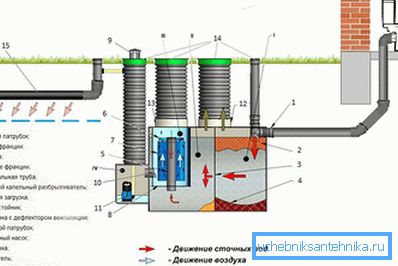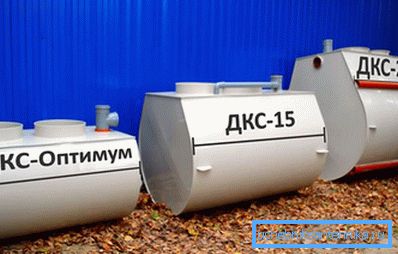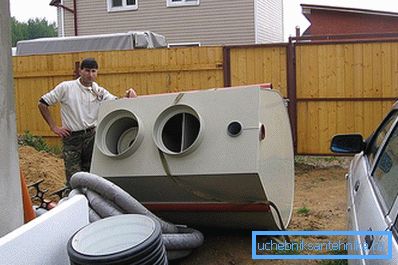Septic dks
The organization of an autonomous system for the recycling of waste products is one of the main tasks to be addressed by the owner of almost any private household that is not connected to a centralized sewage system. A simple cesspool is not always able to cope with loads, moreover, it does not guarantee protection against the penetration of unpleasant odors or ingress of sewage into groundwater. In this case, the installation of a waste treatment system, based on special elements - septic tanks, will be much more efficient. Among the most famous and effective of them, thanks to its operational characteristics, the septic tank DKS stands out. Some features and characteristics of the device will be discussed further.
general description

For a start, it is important to determine the subject matter. Septic tank is called a special device designed for the collection, filtration, storage and partial recycling of human waste. Speaking in general terms, a septic tank consists of several interconnected reservoirs, passing through which fecal masses are divided into fractions, some of which remain inside, and some are removed in a natural way.
Septic tank device

As for the structure of the considered septic tank DKS, it should be noted that it consists of several components:
- Primary camera. It is a reservoir in which the initial accumulation and storage of wastewater is made. In this compartment of the septic tank, the primary separation of waste mass into fractions is carried out. Heavier impurities settle to the bottom, and liquid impurities follow.
- Secondary camera. This is essentially the same reservoir as the first one, but here, in addition to additional separation into fractions, there is bacterial decomposition of the waste.
- The third camera. In this tank, the final filtration of wastewaters and the withdrawal of practically treated water outside the hull are performed. The drains, having passed through the drainage layers, will be finally cleaned and there will be no harm to the environment.
The fractions remaining inside the septic tank are decomposed with the help of bacteria, while the gases released during this process are reliably kept inside the tanks with the help of water gates.
All components of the DKS septic tank are located in a single plastic case, which simplifies installation, and therefore reduces the time and cost of the work.
Septic tank models

It is important to note that DKS septic tanks can be supplied in a number of models, which, despite their structural similarity, may have some differences.
- "DKS Mini" - this model is characterized by small dimensions and a relatively small capacity of about 120 liters of waste per day. The option is appropriate for installation in the conditions of country use.
- "DKS Optimum" - this model has an optimal ratio of dimensions and performance. The septic tank can process up to 250 liters of waste per day, while its dimensions are quite small, and therefore it is installed for an ordinary private house.
- "DKS 15" and "DKS 25" are capable of receiving 450 and 750 liters per day, respectively, and are models that can cope with the loads of a rather large private household.
In addition to DKS septic tanks, there are modifications of IBO devices, which are characterized by large volumes and can be used to service hotels, bathhouses and commercial premises.
Installation and Maintenance Rules

It is not necessary for the user to know how the septic tank works in detail, but to navigate in choosing the site and observing the necessary installation and operation rules is necessary to a greater extent. Violations committed at this stage can lead to breakdowns, however perfect the system may be.
- First of all, it is necessary to take into account the depth of groundwater. It is worth making a reservation here that in order for the device to work correctly, its installation must be carried out in soils with groundwater that does not exceed 2.5 meters.
- The volumes of septic tanks should be selected based on the number of people living in the house.
- The septic tank should be cleaned at least once every two years, and routine maintenance should be carried out at least once a month. As a rule, there are no problems with the operation of the device, but it is worth paying attention to the cleanliness of the ventilation openings necessary for air penetration into the tanks, as this is necessary for the operation of the septic tank.
- If the septic tank is installed in soils with a strong freezing, the body should be insulated with special materials.
- When choosing a place to install a septic tank, you should pay attention to the need for free space, which will be required for travel and equipment operation during installation and further maintenance of the device.
- The distance from the outlet of the effluent to the septic tank itself should not exceed 20 meters. The optimum value will be about 15 m.
- When laying pipes leading to a septic tank, a large number of bends should be avoided, which can lead to problems in the future.
- It is better to lay the pipes leading to the septic tank away from the pedestrian or travel zones of the site, and also to dig in under a slight bias, and the depth of the pipes should not be less than 0.6 meters.
- If the soil at the site of installation of the septic tank is wet or there is a high level of groundwater, care should be taken to install additional drainage pipes.
Concluding the foregoing, it can be noted that the septic tank DKS is one of the most acceptable solutions to the issue of waste disposal. The device has all the excellent characteristics that confirm the positive reviews, and a diverse range allows you to choose a septic tank for specific tasks and conditions of use.
Video
This video provides an overview of DKS septic tanks:
The principle of operation of the septic tank DKS look in this video: